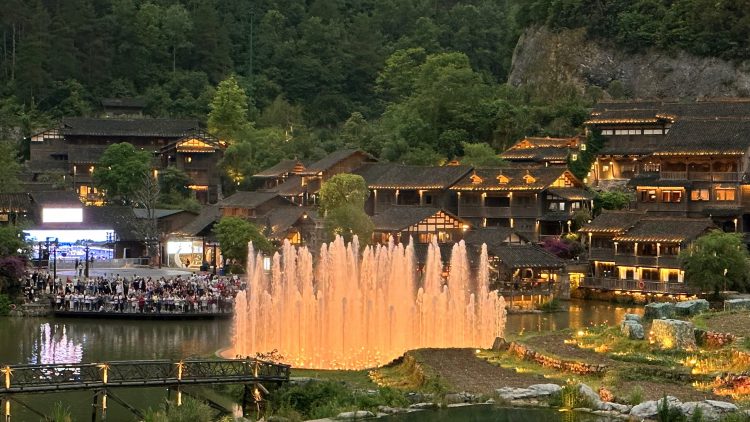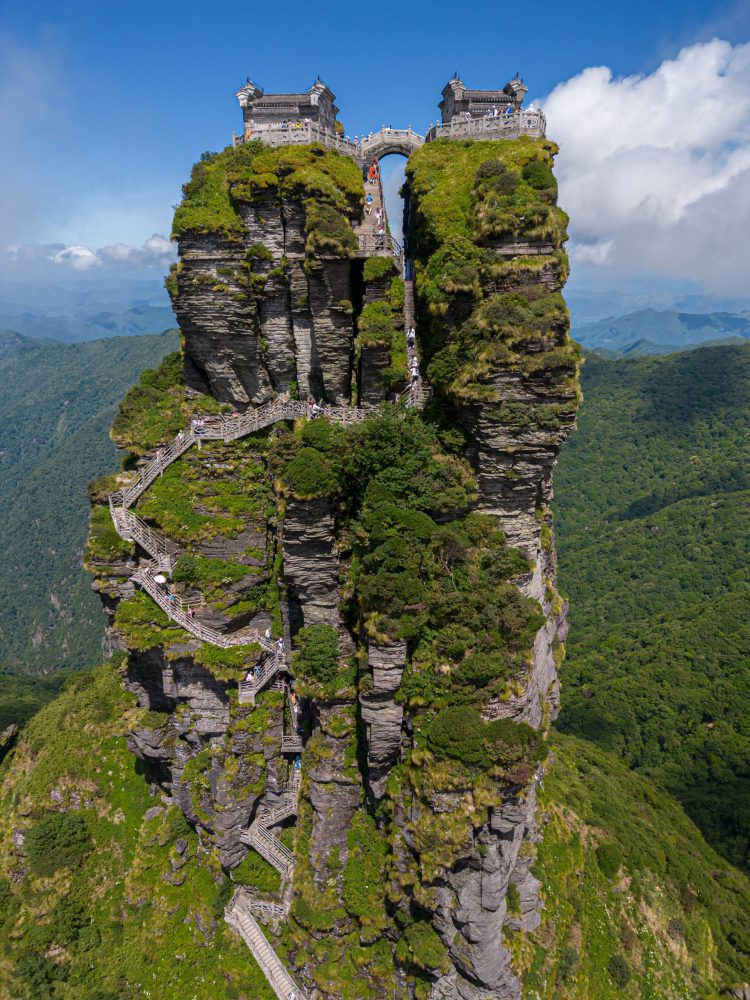A truly invigorating place – by leesan
Guizhou Province is blessed with many beautiful natural attractions, and a hot chilli sauce.
ONE could say that the Chinese province of Guizhou’s slogan, “Invigorating Guizhou”, is pretty accurate. While many parts of the world are currently experiencing either a heat wave or unpredictable weather, the temperature in Guizhou during this summer is between 18ºC and 25ºC. It is surprisingly cooling and, yes, invigorating!
As such, Guizhou will probably come to mind when people from all over China think of a place to holiday to beat the summer heat.

Embrace nature and enjoy peace of mind at Wujiang Village in Guizhou. — Photos: Leesan
In Guizhou cities and counties such as Zhijin and Zunyi, for instance, the weather is cool yet still warm enough for an excellent retreat. And as if that’s not enough, the country’s tech giants like Lixiang, Tencent and JD.com are moving their big data processing centres to the caves of Guiyang to fend off overheating issues.
The inland province of Guizhou has a land mass of 176,110sq km, 90% of which is mountainous terrains straddled by rivers and streams, with almost no flat plains. Even the provincial capital of Guiyang with its population of five million is perched at a height of 1,275m, and almost all of the inhabitable and arable lands in the 88 counties and municipalities in the province are tucked snugly in narrow valleys and riverine ravines that put the province’s transportation capability to serious test.
Fortunately, Guizhou has witnessed an influx of capital and labour from the rest of the country, significantly improving its infrastructure, including criss-crossing freeways and elevated highways, as well as a comprehensive network of high-speed railways. It has also impressively refurbished old town quarters into modern housing precincts.
The residents of Guizhou have been basking in a “Golden 10 Years” of breakneck development. However, they now have to bear the brunt of excessive public debt as a result of over-development since the onset of the coronavirus pandemic. That said, the majority of people in Guizhou are optimistic that things will turn around.
They are used to the rustic lifestyle in a pristine and refreshing environment. They are grateful for their gift from Mother Nature, with countless towering mountains, lush forests and rivers making a confluence in Guizhou. The entire ecosystem there is perfectly preserved, including the truly beautiful Huangguoshu Waterfall.
The 17 minority groups and residents that can be found in 14 indigenous hamlets in Guizhou are also blessed with gorgeous landscapes. Chua, a retired health minister, told me that the indigenous peoples of Guizhou, in particular those from the Yi, Miao, Bouyei, Dong, Tujia and Sui minority groups, would customarily put on their traditional ethnic costumes and perform some folk songs. This is good to know as we get the most rewarding experience during our travels when we immerse ourselves in the local culture and lifestyle.
I love the traditional snacks and culinary styles of Guizhou, too. Even a seemingly simple plate of fried highland cabbage is given a sensory boost with a sprinkle of highland spices and chillies. Terry and Su Cheng, my friends from a Guizhou inbound travel agency, made special arrangements for me to try the local specialty dish, a sour fish soup. This dish features freshwater fish such as grass carp, carp or snakehead, that’s stewed in a well-spiced sour broth.

Huangguoshu Waterfall is the largest waterfall in China and East asia, measuring at 77.8m high and 101m wide.

The 403 square kilometre Mount Fanjing in Guizhou was listed by UNESCO as a world natural heritage site in 2018. And the key lies with the site’s isolated and unique natural ecosystem that has gone through millennia of natural evolution to stand out prominently today as a diverse biosphere reserve with its rich fauna and flora.
Of course, a visit to Guizhou is not complete without savouring the legendary Maotai wine. A bottle of Guizhou Maotai fetches a manufacturer’s price of CNY1,499 (RM950) on average, but this will increase as the liquor ages. It is also normally “out of stock” so the price will increase even more.
A casual chat with Guizhou friends over dinner will most likely include a bottle of Maotai, along with Maotai ice cream, too. It is commonly said that a Maotai factory can feed the entire population of Guizhou province!
Did you know that the famous Lao Gan Ma chilli sauce is also a Guizhou specialty? It boasts an annual turnover in excess of CNY5bil (RM3.17bil). Su handed me a bottle of the chilli sauce to try and said, “This is the original Guizhou Lao Gan Ma chili sauce founded in 1984. It is the best among China’s top five chilli sauces, which uses the province’s small chillies. It has a unique aroma, something that is always missed by Guizhou natives living far away from home.”
Unfortunately, after the founder’s son took over the business from her, he changed the type of chilli used in the sauces and as a result, Lao Gan Ma’s sales plummeted.
As we were busy visiting other attractions, I started to wonder, even though this province is far from major population centres, Guizhou with its population of 38.56 million shouldn’t have become so impoverished. Could it be because the provincial government’s reserves have dried up after the pandemic?
Guizhou is blessed with a wealth of natural resources, though, and being able to make its residents satisfied and happy should be the biggest source of happiness for the province.
There is also Guizhou’s “Tianyan” (Sky Eye). Thanks to its pristine natural environment, clean air and high visibility, a village in Pingtan county has been selected as the site for the world’s biggest 500m-diameter telescope which many in the province take great pride in.
For so many years I have been impressed by the farsighted-ness of China’s private businesses, as well as its provincial and county governments for their dedicated efforts in promoting local tourism. They have helped create countless job opportunities for local residents.
Once such local is Zhang, our tour guide at Wujiang Village. He is super friendly, and a native of Zunyi.
Wujiang Village has been a CNY5bil (RM3.17bil) tourism project that covers a land area of 4.5sq km, and includes 12 different street zones. The village was created by integrating the locality’s natural relief and hilly terrains. During this year’s Labour Day holidays, the newly opened Wujiang Village hosted more than 30,000 visitors.
Another “AAAAA-grade” scenic area is the 126sq km Baili azalea forest, which is teeming with over 60 species of wild azalea trees (the oldest being 1,260 years old). These flowers will fully bloom every April; this is when more than two million domestic tourists flock to the place to admire the gorgeous azaleas.
Similarly, the Pingyuan ancient town known for its mild weather throughout the year is always packed with tourists.
Sadly, I didn’t get to visit the Zhijin Cave National Geopark and Mount Fanjing Buddhist site this time around. Perhaps you can join me in checking these places out in the future?
As we were about to leave the provincial capital of Guiyang, Terry told me about the 1935 Zunyi Meeting, a landmark historical event that confirmed Mao Zedong’s leadership status in the Communist Party as well as the Red Army. Additionally, he also mentioned Han Hong’s famous song The Sky Is Getting Clear, and how Guizhou was the inspiration behind the track.
In short, even if Guizhou is relatively poor, it is richly blessed with breathtaking natural beauty, and a worthwhile destination to visit, especially if you’re looking for new experiences.
Leesan, the globe-trotting traveller who has visited 137 countries and seven continents, enjoys sharing his travel stories and insights. He has also authored five books.

Published in STAR 2, 22 July 2023
全球超过80000家酒店,Apple101助您轻松订房,出行无忧,绝对优惠价。入住期间付款,多数客房可免费取消!











